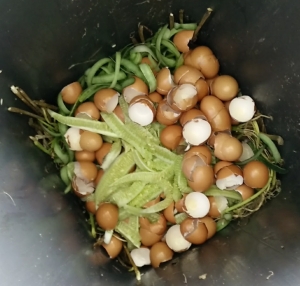It has been a year since we started the food garden at Project Canossian. One year ago, the same place was a flat grass patch. Today, there are over 50 species of food plants growing happily. Not to mention the birds, butterflies, dragonflies, grasshoppers (huge ones), snails (too many!), and more.

The garden after a year of growth…
The garden has been dynamic, starting from legumes for green manure, moving to annuals like okra, and now to a multi-layered perennial system. The tapiocas are probably getting the MVP award, growing rapidly to give high shade and also providing lots of tubers and yummy shoots. Some of the fruit trees are growing better while some got their feet in waterlogged soil and seem stagnant. The snail infestation causes a high rate of seedling mortality. However for all the anguish they cause, the snails also poop copiously and provide our only source of animal protein from this garden (yes, we have tried and they are edible).
We have had more freedom in how we maintain this garden compared to the typical “neat and tidy” gardens around Singapore. We took the opportunity to spend time on protracted observation rather than being reactive to every issue. We sometimes let the weeds grow more rampant than our usual tolerance threshold (which is already pretty high relative to most gardeners). Snails, grasshoppers, caterpillars are typically left to their own devices. Masanobu Fukuoka might give us a pat on the back while meticulous weeders shocked by our laziness. Continue reading




